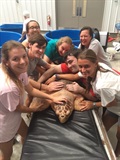
Our summer interns have scattered back to various parts of the country after winding up their three month program with an action packed week.
Our turtle vet, Dr. Craig Harms came down from CMAST (Morehead City) on Tuesday with a long “to do” list: turtles to examine, treatments to update, blood to draw and radiographs to shoot and review. Our regular hospital volunteers were all back on deck as of last week so we let the interns spend the day with the good doctor while we handled the tours.
Things were going smoothly, with visitors making their way through the education stations, past the Sick Bay windows and into the big house – Sea Turtle Bay. Interns were hustling the little turtles back and forth from the therapy pool and radiograph area and stopping a bit to let the visitors get a photo or two.
About halfway through the tours Dr. Harms ran out of the little critters and set his sights on two of our big loggerhead girls: Daisy and Trillium.
Daisy was admitted in late spring with a fishing line wrapped around her front flipper near her shoulder. It had cut deeply into the flipper, almost to the bone, and the flipper was swollen to about three times its normal size. We were concerned that she might actually lose that flipper – it was that terrifying to look at. She was a model patient, generally swimming calmly around her tank, and a perfect lady when she came down for her extensive daily treatment. She was also a quick healer and after her mandatory quarantine period was moved into a large tank in Sea Turtle Bay that became available after our last release. By then she was feeling really good. Room service delivered her breakfast (about five pounds of fish and squid) every morning, and then her tank was all spiffed up and she had a nice exfoliating treatment – a back scrub with a stiff bush. Daisy is a perpetual motion turtle; she’s up with the first light and she even eats on the fly. She’s already got her route back home planned out and is just waiting for the day Dr. Harms gives her the thumbs up.
You can’t examine an almost 300 lb. loggerhead in 3-ft.of water. She had to come out of her tank.
While our visitors wandered through, the interns started pumping out Daisy’s water, but for some reason they decided that the last 6-inches or so wouldn’t present an issue in wrangling the turtle.
Hah!
Sea turtles are incredibly powerful, and Daisy was still in her element. She ruled the process.
Seven interns tried catching her: flippers flailed, water flew five feet into the air and the interns dropped like flies.
Lesson learned the hard (and wet) way: take ALL of the water out of the tank when dealing with a big turtle.
Daisy knew exactly what was up. Not only was her water quickly draining but she could see her doctor standing there with his headlamp.
You could almost hear her thinking “no way!”
As you might imagine by now Daisy had pretty much stopped the tours. Our visitors were rooted to their spots along the railing, waiting with baited breath to see who would win the battle. The odds kept changing but most of them had their money on Daisy.
Now that the tank was finally pumped dry the interns regrouped and went back in with Plan B. This time they were successful in corralling her and lifting her out and onto the gurney so Dr. Harms could get a good look.
Daisy was not happy, and she directed her resentment at our interns who were holding on to every part of her that they could to keep her from launching herself into space during her exam.
Finally turtle, interns and Dr. Harms came to an understanding and Daisy cooperated after being promised that she would be back in her tank with her water if she would just hold still for a bit.
And Trillium? She was an angel during her exam. Maybe she was embarrassed by Miss Daisy’s behavior, or maybe since her tank was so close to the observation ramp she was posing for pictures. At any rate the interns were certainly happy not to have to deal with a repeat performance by another big loggerhead.
Daisy left a lasting impression on not only the interns but also the visitors who happened to be on the ramp at the time. They left saying that they had a much greater appreciation for the work that we do at the hospital.
And if you were in line Tuesday wondering why it was moving so slowly – now you know.
Daisy hopes that you will accept her apology.
By Karen Sota
Karen Beasley Sea Turtle Rescue and Rehabilitation Center Media Coordinator



